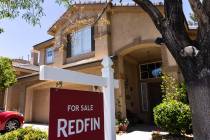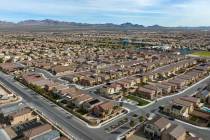UPSIDE DOWN
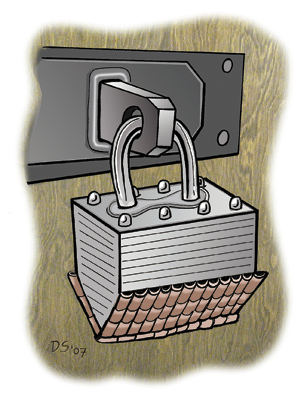

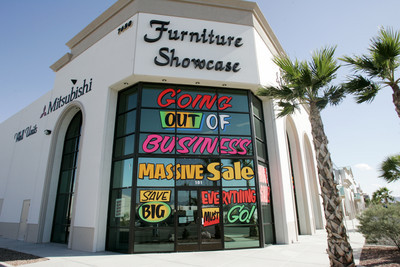

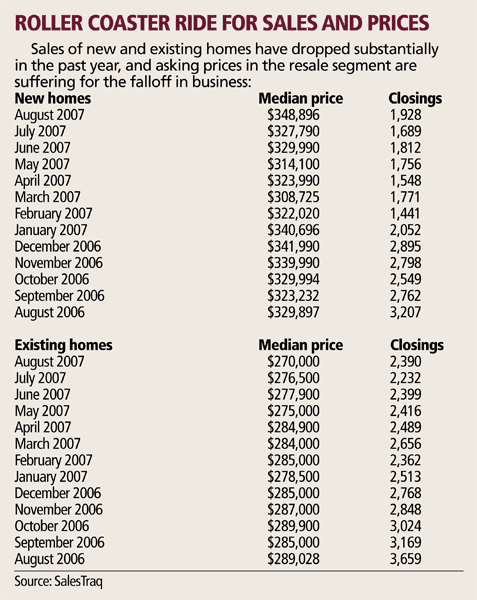


Odds are, you think this package on rising foreclosure rates doesn’t apply to you.
A good 80 percent of home loans in Nevada are prime mortgages, after all, and more than 95 percent of mortgage holders in the state are current on their loan payments. Fewer than 2 percent of home loans are in foreclosure now. The 37 percent of locals who rent their homes have no mortgages to repay, and they’re enjoying stable lease rates to boot.
But the stumbling housing market has tentacles that could reach into every household in the Silver State.
From thousands of lost jobs to widespread housing depreciation to a dip in the revenue flowing into state and county coffers, the fiscal fallout of a lagging housing sector is settling across Nevada’s economy.
"All sectors are feeling the effects of (greater delinquencies and dropping home prices)," said Brian Gordon, a principal in the economic research firm of Applied Analysis. "It’s impacting the willingness of consumers to spend on discretionary purchases ranging from automobiles to dining out to gaming, and everything in between."
Added Mike Colpitts, editor of Housingpredictor.com: "It will be harder to get mortgages. As home values drop and interest rates (on exotic loans) reset, people won’t have extra cash on hand. People won’t go to the movies as much. This is a huge country full of people who have not been savers."
In other words, all consumers could feel the pinch, whether it’s in lost income, smaller home equities or reduced public services.
JOB LOSSES INCREASE
For much of the past two decades, construction and real estate have helped power Nevada’s economy, employing roughly 10 percent of the state’s residents. Construction is the No. 2 employer in Clark County, second only to travel and tourism, said Steve Holloway, executive vice president of the local chapter of Associated General Contractors.
That reliance on growth makes the local economy especially vulnerable when real estate heads south.
Clark County’s construction sector shed more than 4,100 jobs between the first quarter of 2006 and the first quarter of 2007, according to the state’s Department of Employment, Training & Rehabilitation.
The employment declines have helped push the jobless rate to its highest levels since 2003. Unemployment reached 5 percent in Clark County in August, up from 4.2 percent in the same month a year ago.
The dip in construction jobs is even stunting overall employment gains in Nevada.
A vibrant construction sector pushed Nevada’s job formation from 5 percent to 6.5 percent in December 2004, said Jim Shabi, an economist with the state’s employment department.
Now, the building sector is dragging down job creation: Take construction out of the equation, and new jobs are forming at a rate of 2 percent a month. Include building, with its employment declines, and the state’s job growth drops to 1.5 percent a month, Shabi said.
Construction work pays well, so any substantial job loss in the sector will hurt consumer spending. The average construction salary in the first quarter ranged from $48,000 a year to $76,000 a year locally, depending on the type of job.
Pile on job contractions in real estate-related fields such as title insurance, mortgage banking and property appraisals, and the effect on consumer spending becomes more acute. Loan brokers and others in real estate financing average around $55,000 to $73,000 a year, while escrow jobs typically pay more than $57,000 annually. Employees in property and casualty insurance take in an average of more than $72,000 a year.
As many locals are learning, though, job loss isn’t the only restraint the housing market is placing on spending.
‘PEOPLE STOP BORROWING’
More than a fifth of loans made in Nevada in 2006 were interest-only mortgages with payments that will rise in coming months and years, according to California research firm LoanPerformance. Another 17 percent of the loans made here last year were option-ARM mortgages that allow homeowners to shift unpaid interest to the loan’s principal. As interest rates on unconventional mortgages reset beyond their introductory "teaser" levels, consumers have less money for nonessential purchases.
Even the holders of conventional, fixed mortgages are feeling the effects of the troubled market. Properties in default are often vacant and ill-maintained, pulling down the values of nearby homes, said Daren Blomquist, a spokesman for the California research firm RealtyTrac.
In addition, foreclosures and homes with seriously delinquent loan payments generally sell for less than market value, and because today’s listing prices are based on yesterday’s sale prices, below-market closings suppress the housing dollars all homeowners can command, Blomquist said.
Falling home prices are also vaporizing assets: Every 1 percent drop in the median single-family home price costs Clark County homeowners $800 million in household wealth, said Jeremy Aguero, another principal at Applied Analysis. Toss in condominiums and town homes, and the impact approaches $1 billion, Aguero said.
The median price of an existing home in Las Vegas was $270,000 in August, down 6.6 percent from $289,028 in August 2006, according to local research firm SalesTraq.
All that vanishing equity is affecting consumer spending, analysts say.
Shoppers base discretionary budgets partly on how their assets are performing. When homes or investments climb in value, a "wealth effect" kicks in, persuading consumers that their flourishing fiscal outlook lets them splurge today and cover their indulgences when they cash in years from now. At the height of the housing market, consumers were extracting burgeoning home equity to finance cars, vacations and shopping sprees, said Joel Naroff, president of Naroff Economic Advisors in Pennsylvania.
The wealth effect is now pulling in the opposite direction. As home prices depreciate, anxious consumers clamp down on unnecessary spending, and banks impose tougher standards on borrowers looking for loans ranging from first mortgages to home-equity lines of credit. The cash-out refinancing that spurred the economy before 2006 has all but disappeared.
"Probably the biggest and most direct immediate impact (of falling prices and the housing credit crunch) is that people have essentially stopped borrowing from their homes," Naroff said. "And it becomes more of a problem as housing prices fall further. A lot of households had been using their homes essentially as ATMs — they’d stick a ‘card’ in and out would come a new kitchen or car. Now, when they stick those cards in, the ATM asks them for more money."
THE ECONOMIC CONSEQUENCES
Slower job formation, rising unemployment, higher housing payments and slumping home equity are slicing into business for local retailers and chipping away at Nevada’s tax revenue.
Statewide sales among car dealers, food stores, furniture retailers, building suppliers and garden shops ebbed year-over-year in July despite about a 5 percent gain in population.
Nevada’s revenue from taxable sales has declined three months in a row, falling 2.6 percent in July when compared with July 2006, and 0.3 percent in June when compared with the same month in 2006. May’s 3.6 percent slide in year-over-year revenue was the biggest drop since December 2001.
Shrinking home equity and rising interest costs on adjustable-rate mortgages are partly to blame for the revenue decline, said Dino DiCianno, executive director of the Nevada Department of Taxation.
"People have a certain level of disposable income," DiCianno said. "They’re having to choose to either make their housing payments or purchase a new vehicle. Do you want to buy a 52-inch plasma-screen TV, or do you want to make a housing payment? Do you want to not buy the TV and purchase a vehicle instead?"
Consumers especially ramp up spending when they buy homes. The average home buyer spends $3,000 to $6,000 on goods including fixtures, furniture and upgrades every time he buys a home, Aguero said. With local home sales down from 6,866 units in August 2006 to 4,318 units in the same month a year later, consumers are investing less in setting up new households.
Some of the city’s biggest retailers, including Walker Furniture and R.C. Willey, didn’t return phone calls seeking comment on furniture and appliance sales. Casino operators including Boyd Gaming, MGM Mirage and Station Casinos declined to comment just before quarterly earnings season on whether the housing market is affecting consumer spending.
Businesses that did comment reported mixed results.
Sales at dealerships open for more than 12 months are up about 5 percent in the past year for Findlay Automotive Group, said Tyler Corder, the car dealer’s chief financial officer.
Yet, Corder said Findlay’s sales probably would show even higher increases if the housing sector were healthier. Between acquaintances and the managers at Findlay’s 18 regional dealerships, Corder knows of a "fair number" of consumers who plan to avoid auto purchases until they can sell their homes.
"They’ll say, ‘My house has been sitting on the market for 90 days and I haven’t had any offers on it,’" Corder said. "I know of a few people who bought second homes as speculative properties, and they’re having difficulty renting out their homes or unloading them."
It’s difficult to find how much of the falloff in taxable sales on cars results from a flagging residential real estate sector, Corder said, because high fuel prices have made smaller vehicles popular. And pint-size cars are less expensive than sport utility vehicles, pickups and sedans. Nevada auto dealers could be moving the same number of cars year-over-year, but if more of those vehicles are small, the dollar volume will drop.
The Department of Taxation doesn’t tally auto sales based on vehicle size or class.
Furniture retailers reported that sales were off more than 10 percent year-over-year in July.
Salesman Wayne Farrar estimated that business is down about 30 percent in the past two to three months at Price Less Furniture on Russell Road. September was especially slow: One Thursday brought in just six customers, compared with 20 to 30 customers on a typical day when times were good.
"If anybody is going into a furniture store today, they are either completely wealthy or they’re buying inexpensive furniture," Farrar said.
Joey Luna, a co-owner of Furniture Direct on Dean Martin Drive, first heard rumblings of a slowdown in furniture manufacturing in late 2006. Slackening sales among retailers followed in the spring; through his company’s Furnitureofamerica.com Web site, Luna noticed softening purchases in Nevada, California, Arizona and Florida in the second quarter. He saw local clients backing out of major furniture purchases, some because they were bracing for higher mortgage payments.
So Furniture Direct is tweaking its operation, focusing on remodeling and making over existing homes. The company, which already emphasizes midrange to high-end furnishings, also opened a division in September for the pricey loft and high-rise segment.
"There’s movement (of homes) in the $2 million-and-above price range," Luna said.
Taxable sales aren’t the only revenue stream drying up because of a faltering housing market.
The real-property transfer tax, which levies $5.10 on every $1,000 of assessed value each time a property sells in Clark County, has plummeted this year thanks to falling prices and fewer sales. Clark County took in about $122 million in real-property transfer tax from January to August, the most recent month with available statistics. That’s down from $159.2 million during the same time in 2006 and $166.4 million in the first eight months of 2005.
The revenue from taxable sales and property transfers supports key public services such as schools, the Southern Nevada Water Authority, prisons, flood control and police departments.
"If revenue comes in substantially under expectations, government agencies will have to adjust their budgets accordingly, and that’s not always an easy thing," Aguero said.
A sustained budget crunch could send officials on the hunt for additional funds, Aguero said. Yet, he doesn’t foresee a revenue fight similar to the budget standoff in 2003, when the Nevada Supreme Court allowed an $833.5 million tax hike to make up for a dip in gaming and taxable sales revenue resulting from the terrorist attacks of Sept. 11, 2001.
The political will for such a tussle doesn’t exist, Aguero said, and the housing bust doesn’t carry the same long-term uncertainty that Sept. 11 did. Plus, Southern Nevada’s resort sector will open more than $30 billion in projects over the next five years or so, thus creating new jobs and boosting the economy. Furthermore, legislative solutions are "less in vogue" than voter initiatives, so if funding fixes become necessary, they’ll probably happen through referendums pitched directly to voters, Aguero predicted.
And ballot questions carry their own dangers.
"Oftentimes, people don’t understand unintended consequences or even principal consequences, especially if you take initiatives in combination with one another," Aguero said. "It becomes hugely problematic. Southern Nevada has a remarkable, robust economy even in relatively slow times. Tinkering with that is dangerous, especially when it’s coming from several different directions."
Whether there’s any tinkering at all, though, will depend on how much the housing market worsens, analysts say.
HOW MUCH WORSE?
Outside home-building and related sectors, most businesses haven’t responded to slower sales with layoffs. Housing analysts and economists say, though, that the housing credit crunch isn’t over, and businesses could face slower sales for several quarters to come.
"Job growth is income growth," Naroff said. "Jobs generate income, so people who say they’re not seeing a lot of problems yet could see problems later. (The credit crunch) is a process, not an event. It accumulates. After a year of 1.4 percent job growth instead of 6 percent job growth, you know spending will be down."
Local companies shouldn’t expect a sales assist from homeowners any time soon.
Exotic mortgages with rising interest rates made up 51 percent of all home loans originated in Nevada in 2006, compared with 33 percent of all home loans nationally, according to LoanPerformance.
LoanPerformance forecasts that homeowners will default on 32 percent of mortgages with initial "teaser" interest rates that jump later. The company also predicts that 12 percent of subprime loans, of which there were 107,622 in Nevada in the second quarter, will end up in foreclosure. About 5 percent of subprime loans are in foreclosure now.
Mortgage delinquencies nationally will not peak until six months to a year from now, predicted Doug Duncan, of the Mortgage Bankers Association. Foreclosures, which lag delinquencies, should hit their high point three months to six months after late payments spike.
Nevada’s mortgage troubles could intensify, but it’s possible the Silver State’s foreclosure rate is peaking earlier than rates in other states, RealtyTrac’s Blomquist said.
Nevada has a typical foreclosure timeline of about four months, compared with more than a year in some states such as New York. Nevada might be the nation’s top default spot now because other states are coming later to the foreclosure issue.
RealtyTrac’s researchers are seeing heightened default activity elsewhere, and they are spotting signs that other states will catch up to Nevada’s foreclosure levels.
"It’s not a sure thing that Nevada will be on top of the foreclosure list for the remainder of the year," Blomquist said.
Industry watchers also point to upsides for the local economy: Business is increasing for some operations, including credit counselors, appliance repairmen and fast-food restaurants.
Sales are "booming" at Mr. Appliance of Las Vegas, as homeowners look to save money by repairing what they already have, Operations Manager Kenneth Jagmin said. And an average tab of $7 a person has helped push same-store sales up by the double digits for Micatrotto Restaurant Group, which owns three local Raising Cane’s chicken-finger eateries and one Baker Bros. American Deli shop.
The slump in residential construction also eased a labor shortage on the Strip, where developers need tens of thousands of workers to build projects such as the $7.4 billion CityCenter and the $4.8 billion Echelon.
Holloway, of Associated General Contractors, said the surfeit of workers has helped avert a 10 percent to 15 percent increase in the cost of construction along the resort corridor.
Nor are slipping sales among some sectors dampening long-term outlooks among business owners and executives.
Despite the drop in business, managers at Price Less aren’t discussing layoffs or salary cuts, Farrar said.
"We’re pretty well-established," Farrar said. "And the way the population is coming into Las Vegas, we’re still going to survive. Las Vegas is a very transient town, so you have people moving in and out, which generates sales. We’ll survive, and hopefully things will turn around."
Furniture Direct even added two workers in September, bringing its staff to 30.
"I think we will be OK," Luna said. "We’ve certainly become more careful about what we show and buy here in the Las Vegas market, but I think people will continue to buy furniture. It’s a matter of refocusing our goals. If we continue to focus on the needs of the local market, I think we will continue to do well."
Housing in Las VegasMore InformationPart 1 of 3 TODAY • Nevada’s stumbling housing market and galloping foreclosures will affect nearly every household in the state. • Meet a hardworking young couple battered badly when the housing bubble burst. • Mortgage broker Jan Stewart knows how to ease the foreclosure crisis. Is anyone listening? MONDAY • Even neighbors who didn’t buy, sell, or borrow against home equity will pay some of the social costs of foreclosures. • The dishonest and criminal helped precipitate the foreclosure crisis and will attempt to profit from it. • An octogenarian tells how "refinancers" tricked her into selling her house. TUESDAY • When does a real estate market crash become an opportunity? • Some bold investors are still buying Las Vegas real estate. • Want to sell? Here is how to move your property faster and more profitably.















